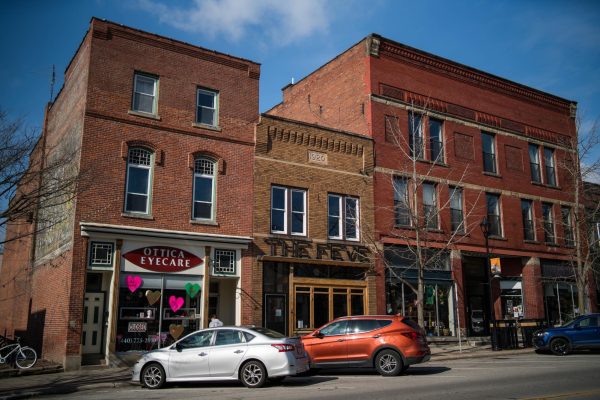Community Members Debate Next Steps for NEXUS
After failing to stop construction of the NEXUS pipeline, protesters and environmental activists are regrouping and planning for what comes next. Some are looking specifically at how to protect Oberlin, some argue that the way forward lies in regional coalitions, and others believe that only radical restructuring, such as creating a landfill gas pipeline, can produce a desired outcome.
Pipeline construction was completed over the summer. On July 25, the Federal Energy Regulatory Commission rejected a request for a rehearing of the construction approval. The request was filed by multiple groups, including the City of Oberlin and Communities for Safe and Sustainable Energy.
Reverends Steve Hammond and John Elder founded CSSE in 2012; a year later, they would be instrumental in passing the Oberlin Community Bill of Rights and Obligations — effectively banning pipelines.
Now that NEXUS is in the ground, Hammond and Elder are looking for ways to mitigate its impact on the community.
“Protests [in other parts of the country] haven’t stopped any pipelines; those pipelines are still being constructed,” Elder said. “So the function of further demonstrations, in my view, would not be to stop the pipeline. They would be to continue educating the public on the impact of the pipelines.”
Central to this goal is teaching community members how to track the potentially negative effects of the pipeline.
“One of the projects that may be going along for people both with CSSE and Students for Energy Justice is the whole idea of training people to monitor what is going on with the pipeline … [such as] our air quality standards,” Hammond said. “Are the kinds of agreements that NEXUS has to make to put the pipeline in, are they living up to those agreements?”
Elaine Tanner, an environmental activist from Polk, Ohio who attended an anti-NEXUS protest in Oberlin over the summer, agrees.
“For me, success would be a monitoring program, by local officials and NEXUS,” she said. “It shouldn’t have to be people living in the area.”
Until that happens, however, Tanner agrees that the next step needs to be a lot of testing — not only of the air and water quality but of people themselves.
“It’s important to establish a baseline of health,” she said. “That way, if something goes wrong, we can see if the pipeline was a factor.”
Yet to Tanner, the NEXUS fight is neither over nor solely local. “We’ve just gotten started. What we need to do is cut the head of the snake,” she said.
Pipelines crisscross the entire state, and for Tanner, their intersections — such as fracking wells near Kensington, Ohio — are where pressure needs to be applied the most.
“I think we need to pull together different regions and see that if we can stop the wells, there won’t be a need for the pipelines,” she said.
However, shutting down fracking in Ohio will likely be met with pushback. Some believe that liquid natural gas (LNG) will aid in the transition from fuels like coal to renewable energy sources.
Professor of Physics John Scofield, while not in favor of the pipeline, believes that its construction should be viewed in a more positive light.
“Switching from coal to natural gas is the single most important act by the College in 50 years in reducing its carbon footprint,” Scofield wrote in a letter he shared with the Review. “It should have been, and would have been accomplished 10 years earlier, had not David Orr and his disciples fought it as they held out for a more perfect solution.”
Scofield is not alone in believing in LNG’s bridging ability. He notes that both of former President Barack Obama’s energy secretaries supported the development of gas.
“The city is wasting its time and money and its energies on [fighting the pipeline],” Scofield said in an interview. “Natural gas is a critical fuel here in town and in our nation, and it cannot be eliminated nationally without major breakthroughs in storage and other energy technologies. Anything Oberlin can do to eliminate natural gas in the near term involves strategies that only make us look green — they do not provide models for other communities.”
David Orr, the Paul Sears distinguished professor of environmental studies and politics emeritus, disagrees.
“Natural gas is a bridge to nowhere,” Orr said. “Developing LNG diverts money away from renewables, methane, a much more potent greenhouse gasleaks out at well sites, and often the full costs of fracking, including the long-term costs of toxic water, are not considered.”
Orr argues that fracking wells don’t last long and that refracking risks tainting either aquifers or waterways — a concern shared by Tanner, Hammond, and Elder.
In order to mitigate the environmental impact, Orr insists that a more radical solution needs to be considered: a landfill gas pipeline.
“Testing is good, but it needs to be kicked up to another level,” Orr said.
According to Orr, the College is considering building a two-mile landfill gas pipeline that would replace its dependency on LNG for heating.
“We need to keep [fossil fuels] in the ground, otherwise the momentum will be too strong and we won’t be able to stop from reaching the two-degree limit that scientists agree would be catastrophic for the earth,” he said.
While debate around the pipeline still rages on, there are those who feel that the issue has become a moot point.
In an email to the Review, City Council President Bryan Burgess wrote, “The pipe is in the ground despite our ongoing legal battle. I consider the issue old news although I understand that returning students might be curious… Anything else. Please.”


